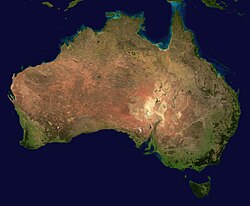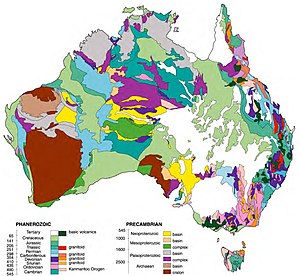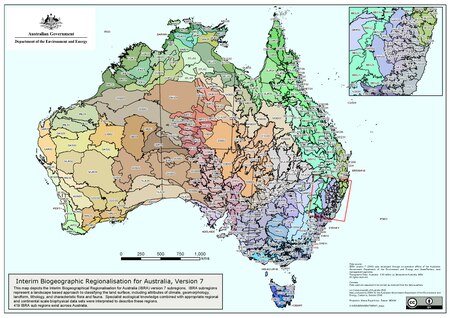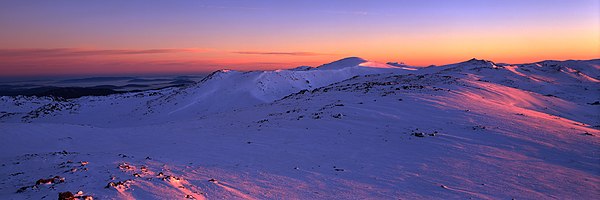Geography of Australia
 | |
| Continent | Oceania (continent) |
|---|---|
| Region | Oceania |
| Coordinates | 27°00′00″S 144°00′00″E / 27.000°S 144.000°E |
| Area | Ranked 6th |
| • Total | 7,688,287[1] km2 (2,968,464 sq mi) |
| • Land | 98,21% |
| • Water | 1,79% |
| Coastline | 59,681 km (37,084 mi) |
| Borders | None |
| Highest point | Mount Kosciuszko 2,228 m (7,310 ft) |
| Lowest point | Lake Eyre, −15 m (−49 ft) |
| Longest river | Murray River, 2,375 km (1,476 mi) |
| Largest lake | Lake Eyre 9,500 km2 (3,668 sq mi) |
| Climate | Mostly desert or semi-arid, south-east and south-west corners: temperate, north: tropical climate, varied between tropical rainforests, grasslands, part desert, mountainous areas: subantarctic tundra |
| Terrain | Mostly low plateau with deserts, rangelands and a fertile plain in the southeast; mountain ranges in the east and south-east. |
| Natural resources | Minerals, coal, and timber |
| Natural hazards | Cyclones along the northern coasts, severe thunderstorms, droughts, occasional floods, heat waves, and frequent bushfires |
| Exclusive economic zone | 8,148,250 km2 (3,146,060 sq mi) |
The geography of Australia encompasses a wide variety of biogeographic regions being the world's smallest continent, while comprising the territory of the sixth-largest country in the world. The population of Australia is concentrated along the eastern and south-eastern coasts. The geography of the continent is extremely diverse, ranging from the snow-capped mountains of the Australian Alps and Tasmania to large deserts, tropical and temperate forests, grasslands, heathlands and woodlands.
The countries that govern nearby regions include Indonesia, East Timor, and Papua New Guinea to the north; the Solomon Islands, Vanuatu, and the French dependency of New Caledonia to the east; and New Zealand to the southeast.
Physical geography


Australia is a country and an island located in Oceania between the Indian Ocean and the South Pacific Ocean. It shares its name with the country that claims control over it. Properly called the Commonwealth of Australia, its territory consists of the entire continent and smaller outlying islands. This makes it the sixth-largest country in the world by area of jurisdiction, which comprises 7,686,850 km2 (2,967,910 sq mi) (including Lord Howe Island and Macquarie Island), which is slightly smaller than the 48 states of the contiguous United States and 31.5 times larger than that of the United Kingdom.
The Australian mainland has a total coastline length of 35,821 km (22,258 mi) with an additional 23,860 km (14,830 mi) of island coastlines.[2] There are 758 estuaries around the country with most located in the tropical and sub-tropical zones.[3] A recent global remote sensing analysis suggested that there was 8,866 km2 (3,423 sq mi) of tidal flat area in Australia, making it the third-ranked country in terms of how much tidal flat occurs there.[4] Australia has the third-largest exclusive economic zone of 8,148,250 km2 (3,146,060 sq mi). This EEZ does not include the Australian Antarctic Territory (an additional 5,896,500 km2 (2,276,700 sq mi)).
Australia has the largest area of ocean jurisdiction of any country on Earth.[5] It has no land borders. The northernmost points of the continental mainland are the Cape York Peninsula of Queensland and the Top End of the Northern Territory, but the northernmost point of the country lies in the Torres Strait Islands.
The western half of Australia consists of the Western Plateau, which rises to mountain heights near the west coast and falls to lower elevations near the continental centre. The Western Plateau region is generally flat, though broken by various mountain ranges such as the Hamersley Range, the MacDonnell Ranges, and the Musgrave Range. Surface water is generally lacking in the Western Plateau, although there are several larger rivers in the west and north, such as the Murchison, Ashburton, and Victoria rivers.
The Eastern Highlands, or Great Dividing Range, lie near the eastern coast of Australia, separating the relatively narrow eastern coastal plain from the rest of the continent. These Eastern Australian temperate forests have the greatest relief, the most rainfall, the most abundant and varied flora and fauna, and the densest human settlement.
Between the Eastern Highlands and the Western Plateau lies the Central Lowlands, which are made up of the Great Artesian Basin and Australia's largest river systems, the Murray-Darling Basin and the Lake Eyre Basin.
Off the north-eastern coast of Australia is the world's largest coral reef complex, the Great Barrier Reef. The large and mountainous island of Tasmania, also a State of Australia, lies south of the south-eastern corner of the Australian mainland. It receives abundant rainfall, and has highly fertile soils particularly in comparison to the mainland.
In Australia forest cover is around 17% of the total land area, equivalent to 134,005,100 hectares (ha) of forest in 2020, up from 133,882,200 hectares (ha) in 1990. In 2020, naturally regenerating forest covered 131,614,800 hectares (ha) and planted forest covered 2,390,300 hectares (ha). Of the naturally regenerating forest 0% was reported to be primary forest (consisting of native tree species with no clearly visible indications of human activity) and around 18% of the forest area was found within protected areas. For the year 2015, 67% of the forest area was reported to be under public ownership, 32% private ownership and 1% with ownership listed as other or unknown. [6] [7]
Geology

Australia is the lowest, flattest, and oldest continental landmass on Earth[8] and it has had a relatively stable geological history. Geological forces such as the tectonic uplift of mountain ranges and clashes between tectonic plates occurred mainly in Australia's early prehistory, when it was still a part of Gondwana. Its highest peak is Mount Kosciuszko at 2,228 m (7,310 ft), which is relatively low in comparison to the highest mountains on other continents.
Charles Rowland Twidale estimates that between 10% and 20% of Australia's modern landscapes formed during the Mesozoic when the continent was part of Gondwana.[9]
Australia is situated in the middle of the tectonic plate, and therefore currently has no active volcanism. Minor earthquakes which produce no damage occur frequently, while major earthquakes measuring greater than magnitude 6 occur on average every five years.[10] The terrain is mostly low plateau with deserts, rangelands and a fertile plain in the southeast. Tasmania and the Australian Alps do not contain any permanent icefields or glaciers, although these may have existed in the past. The Great Barrier Reef, by far the world's largest coral reef, lies a short distance off the north-east coast.
Regions

The Australian continental landmass consists of six distinct landform divisions.[11] These are:
- The Eastern Highlands—including the Great Dividing Range, the fertile Brigalow Belt strip of grassland behind the east coast, and the Eastern Uplands
- The Eastern alluvial Plains and Lowlands—the Murray Darling basin covers the southern part; also includes parts of the Lake Eyre Basin and extends to the Gulf of Carpentaria
- The South Australian Highlands—including the Flinders Range, Eyre Peninsula, and Yorke Peninsula
- The Western Plateau—including the Nullarbor Plain
- The Central Deserts
- Northern Plateau and Basins—including the Top End
Hydrology


Much of Australia's interior is arid; the low average annual rainfall and high temperatures mean interior rivers are often dry and lakes empty. The headwaters of some waterways are located in tropical regions where summer rains create a high rate of discharge. Flood events drastically alter the dry environment; thus the ecology of central Australia has had to adapt to the boom and bust cycle.
The Great Artesian Basin is an important source of water, the world's largest and deepest fresh water basin. Access to water from the basin has led to the expansion of grazing into areas that were previously far too dry for livestock. Towns and cities across the country sometimes face major water storage and usage crises in which restrictions and other measures are implemented to reduce water consumption. Water restrictions are based on a gradient of activities that become progressively banned as the situation worsens.
Billabong is the Australian name given to the oxbow lakes that can form along a meandering river's course. In a worldwide comparison of height, Australia's waterfalls are relatively insignificant, with the longest drop ranked 135th according to the World Waterfall Database.[12]
Political geography
<imagemap> File:Map_of_Australia.png|328px|thumb|A clickable map of Australia's states, mainland territories and their capitals
rect 30 223 63 238 Perth rect 149 244 201 258 Adelaide rect 183 280 247 294 Melbourne rect 273 262 325 273 Canberra rect 285 239 326 255 Sydney rect 260 188 315 204 Brisbane rect 136 58 178 74 Darwin rect 251 327 294 342 Hobart rect 258 317 311 327 Tasmania rect 241 256 269 264 Australian Capital Territory poly 271 268 268 266 270 261 275 263 Australian Capital Territory
poly 123 82 129 226 114 232 107 232 95 239 90 247 70 248 61 252 48 261 36 261 27 254 33 242 22 213 7 191 14 189 6 178 7 165 4 157 9 153 11 154 27 139 34 139 46 131 61 128 71 112 68 105 73 101 79 106 82 102 80 97 88 97 87 89 96 81 108 74 Western Australia poly 123 82 127 176 196 177 200 96 178 80 183 73 182 68 187 67 191 61 187 58 163 56 155 49 149 51 154 56 139 59 134 68 129 75 130 82 Northern Territory poly 130 226 128 176 219 177 214 282 207 279 207 267 204 258 197 261 197 252 191 249 195 238 194 235 188 244 179 249 171 239 169 237 165 230 153 228 147 223 South Australia poly 199 96 196 177 219 177 218 202 275 208 283 205 287 205 295 210 300 209 302 205 307 205 313 206 314 185 299 164 299 155 294 153 291 154 285 133 276 128 276 126 270 126 266 115 265 104 263 102 261 86 256 81 249 80 247 66 240 48 233 62 233 65 230 78 229 91 224 104 215 107 Queensland poly 218 203 273 208 284 204 296 210 300 210 302 206 313 204 312 213 306 231 301 241 291 248 285 263 277 281 265 275 264 266 252 267 242 264 241 265 233 258 232 254 227 253 224 248 215 246 New South Wales poly 215 246 213 281 219 287 229 290 239 286 242 282 245 289 249 293 260 287 276 284 265 275 264 267 255 267 245 264 242 266 233 257 228 253 224 247 Victoria poly 238 307 241 307 249 313 261 309 262 312 262 321 257 329 250 335 241 325 Tasmania
rect 115 264 182 285 Great Australian Bight rect 277 297 312 317 Tasman Sea rect 13 74 57 99 Indian Ocean rect 290 73 320 96 Coral Sea rect 51 4 136 18 Indonesia rect 241 1 309 27 Papua New Guinea rect 187 69 229 88 Gulf of Carpentaria rect 148 30 202 44 Arafura Sea rect 104 26 134 45 East Timor rect 104 45 130 66 Timor Sea
poly 248 56 265 106 295 139 302 120 261 54 Great Barrier Reef
</imagemap> Australia consists of six states, two major mainland territories, and other minor territories. The states are New South Wales, Queensland, South Australia, Tasmania, Victoria, and Western Australia. The two major mainland territories are the Northern Territory and the Australian Capital Territory. Western Australia is the largest state, covering just under one third of the Australian landmass, followed by Queensland, South Australia, and New South Wales.
Australia also has several minor territories; the federal government administers a separate area within New South Wales, the Jervis Bay Territory, as a naval base and seaport for the national capital. In addition Australia has the following inhabited, external territories: Norfolk Island, Christmas Island, Cocos (Keeling) Islands, and several largely uninhabited external territories: Ashmore and Cartier Islands, Coral Sea Islands, and Heard Island and McDonald Islands. Australia also claims a portion of Antarctica as the Australian Antarctic Territory, although this claim is not widely recognized.
Human geography
This section needs expansion. You can help by adding to it. (January 2022) |
Australians have settled in several capital cities and their suburban satellites at various points along a vast coastline. A significant immigrant population occupied these places with relatively little dispute and few inner city ghettoes.[13] Australia’s mean population density is 3.3/km2, one of the lowest in the world.[14]
Sport plays an important social and cultural role in Australia with more than 90% of adults having an interest in sport.[15] English is the most common language in Australia. Australians enjoy a very high rate of private property ownership.[13] Australians have a preponderance to engage in gambling, experiencing the largest per capita losses in the world.[16]
Climate

By far the largest part of Australia is arid or semi-arid. A total of 18% of Australia's mainland consists of named deserts,[17] while additional areas are considered to have a desert climate based on low rainfall and high temperature. Only the south-east and south-west corners have a temperate climate and moderately fertile soil. The northern part of the continent has a tropical climate: part is tropical rainforests, part grasslands, and part desert.
Rainfall is highly variable, with frequent droughts lasting several seasons thought to be caused in part by the El Niño-Southern Oscillation. Occasionally a dust storm will blanket a region or even several states and there are reports of the occasional large tornado. Rising levels of salinity and desertification in some areas is ravaging the landscape.
Australia's tropical/subtropical location and cold waters off the western coast make most of western Australia a hot desert, with aridity a marked feature of the greater part of the continent. These cold waters produce little moisture needed on the mainland. A 2005 study by Australian and American researchers investigated the desertification of the interior, and suggested that one explanation was related to human settlers who arrived about 50,000 years ago. Regular burning by these settlers could have prevented monsoons from reaching interior Australia. The outback covers 70 percent of the continent.
Natural hazards
Cyclones along the northern coasts, severe thunderstorms, droughts, occasional floods, heat waves, and frequent bushfires are natural hazards that are present in Australia.[citation needed]
Environment

Current environmental issues include: soil erosion from overgrazing, industrial development, urbanization, and poor farming practices; soil salinity rising due to the use of poor quality water; desertification (partly as a result of the introduction by European settlers of rabbits); introduced pest species; clearing for agricultural purposes threatens the natural habitat of many unique animal and plant species; the Great Barrier Reef off the northeast coast, the largest coral reef in the world, is threatened by increased shipping and its popularity as a tourist site; limited natural fresh water resources; and threats from invasive species.
International agreements:
- party to: Antarctic-Environmental Protocol, Antarctic Treaty, Kyoto Protocol, Biodiversity, China–Australia Migratory Bird Agreement, Climate Change, Endangered Species, Environmental Modification, Hazardous Wastes, Japan–Australia Migratory Bird Agreement, Law of the Sea, Marine Dumping, Marine Life Conservation, Nuclear Test Ban 1963, Nuclear Non-Proliferation, Ozone Layer Protection, Ship Pollution, Tropical Timber 1994, Ramsar Convention, Whaling
- signed, but not ratified: Desertification





See also
Lua error in mw.title.lua at line 346: bad argument #2 to 'title.new' (unrecognized namespace name 'Portal').
- Australasian realm
- Australia-New Guinea
- List of cities in Australia by population
- List of extreme points of Australia
- List of islands of Australia
- List of lakes of Australia
- List of mountains in Australia
- List of regions of Australia
- List of rivers of Australia
- List of drainage basins of Australia
- List of valleys of Australia
- List of waterfalls of Australia
- Protected areas of Australia
References
- ^ "Area of Australia - States and Territories". 27 June 2014.
- ^ "Border Lengths – States and Territories". Geoscience Australia. Commonwealth of Australia. 2004. Retrieved 18 August 2016.
- ^ Dennison, William C.; Abal, Eva G. (1999). Moreton Bay Study: A Scientific Basis for the Healthy Waterways Campaign. Brisbane: South East Queensland Regional Water Quality Management Strategy Team. p. 220. ISBN 0-9586368-1-8.
- ^ Murray, N.J.; Phinn, S.R.; DeWitt, M.; Ferrari, R.; Johnston, R.; Lyons, M.B.; Clinton, N.; Thau, D.; Fuller, R.A. (2019). "The global distribution and trajectory of tidal flats". Nature. 565 (7738): 222–225. doi:10.1038/s41586-018-0805-8. PMID 30568300. S2CID 56481043.
- ^ Non-Fisheries Uses in Australia's Marine Jurisdiction National Marine Atlas. Department of the Environment, Water, Heritage and the Arts
- ^ Terms and Definitions FRA 2025 Forest Resources Assessment, Working Paper 194. Food and Agriculture Organization of the United Nations. 2023.
- ^ "Global Forest Resources Assessment 2020, Australia". Food Agriculture Organization of the United Nations.
- ^ Pain, C.F., Villans, B.J., Roach, I.C., Worrall, L. & Wilford, J.R. (2012): Old, flat and red – Australia's distinctive landscape. In: Shaping a Nation: A Geology of Australia. Blewitt, R.S. (Ed.) Geoscience Australia and ANU E Press, Canberra. pp. 227–275 ISBN 978-1-922103-43-7
- ^ Rowland, C.R. (1994). "Gondwanan (Late Jurassic and Cretaceous) palaeosurfaces of the Australian craton". Palaeogeography, Palaeoclimatology, Palaeoecology. 112 (1–2): 157–186. Bibcode:1994PPP...112..157T. doi:10.1016/0031-0182(94)90139-2.
- ^ Mccue, Kevin (26 February 2010). "Land of earthquakes and volcanoes?". Australian Geographic. Archived from the original on 6 March 2010. Retrieved 25 April 2010.
- ^ Loffler, Ernst; Anneliese Loffler; A. J. Rose; Denis Warner (1983). Australia:Portrait of a continent. Hutchinson Group. p. 18. ISBN 0-09-130460-1.
- ^ "Significant Waterfalls". Geoscience Australia. Commonwealth of Australia. Archived from the original on 25 May 2010. Retrieved 11 June 2010.
- ^ 13.0 13.1 Peace, Adrian (2015). "Australia, Sociocultural Overviews: Australian Settler Society". International Encyclopedia of the Social & Behavioral Sciences (Second Edition): 239–244. doi:10.1016/B978-0-08-097086-8.12022-7. ISBN 9780080970875. Retrieved 21 October 2022.
- ^ Neill, Simon P.; Hemer, Mark; Robins, Peter E.; Griffiths, Alana; Furnish, Aaron; Angeloudis, Athanasios (June 2021). "Tidal range resource of Australia". Renewable Energy. 170: 683–692. Bibcode:2021REne..170..683N. doi:10.1016/j.renene.2021.02.035. hdl:20.500.11820/39c65964-e961-4018-ac46-e67faeadf447. S2CID 233552671.
- ^ "About sport in Australia". Department of Health and Aged Care. Commonwealth of Australia. 22 February 2022. Retrieved 22 October 2022.
- ^ "Gambling in Australia". Australian Institute of Health and Welfare. Retrieved 27 October 2022.
- ^ "Deserts". [. Commonwealth of Australia. Archived from the original on 5 December 2009. Retrieved 11 June 2010.
 This article incorporates public domain material from The World Factbook (2025 ed.). CIA. (Archived 2000 edition.)
This article incorporates public domain material from The World Factbook (2025 ed.). CIA. (Archived 2000 edition.)
Further reading
- Miller, Gifford; Mangan, Jennifer; Pollard, David; Thompson, Starley; Felzer, Benjamin; Magee, John (2005). "Sensitivity of the Australian Monsoon to insolation and vegetation: Implications for human impact on continental moisture balance". Geology. 33 (1): 65–68. Bibcode:2005Geo....33...65M. doi:10.1130/G21033.1.
- "Highest Mountains". National Mapping – Fab Facts, Landforms, Australian Mountains. Archived from the original on 17 June 2005. Retrieved 7 July 2005.
- Weatherley, A.H., ed. (1967). Australian Inland Waters and their Fauna. Eleven Studies (PDF, 19Mb). Canberra: Australian National University Press. OCLC 594806492.
External links
- (in English and French) Map of Australia from 1826
 Wikimedia Atlas of Australia
Wikimedia Atlas of Australia- (in English) Water Usage in Australia
- Short description with empty Wikidata description
- Use Australian English from July 2011
- All Wikipedia articles written in Australian English
- Coordinates not on Wikidata
- Articles with unsourced statements from August 2021
- Articles with invalid date parameter in template
- Wikipedia articles incorporating text from the World Factbook
- Articles with French-language sources (fr)
- Geography of Australia